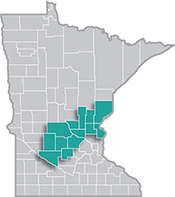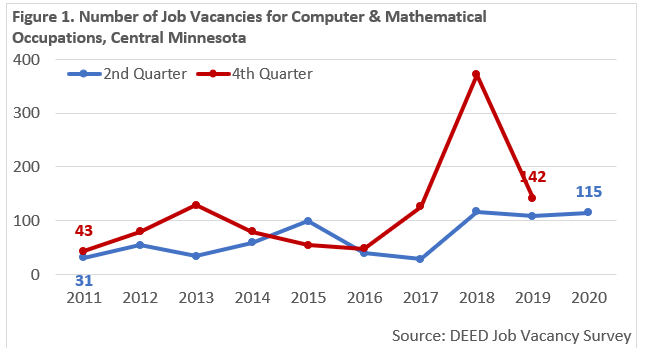 Central Minnesota is a manufacturing stronghold, with several global manufacturing firms operating there.
Central Minnesota is a manufacturing stronghold, with several global manufacturing firms operating there.
The region is especially well known for its expertise in food processing, printing, furniture manufacturing, appliances, machinery and heavy equipment manufacturing.
View our latest blogs on CareerForce. Want the freshest data delivered by email? Subscribe to our regional newsletters.
3/31/2021 9:00:00 AM
Luke Greiner
The Information Technology (IT) field includes a number of occupations, ranging from computer user support specialists to software developers to computer systems analysts. According to DEED's Occupational Employment Statistics (OES) data, the 13-county Central Minnesota region was home to around 5,000 workers in IT occupations, which are formally classified in Standard Occupational Classification (SOC) codes as "Computer and Mathematical Occupations." At that level, these occupations accounted for about 1.8% of total employment in the region, compared to 3.8% of total employment statewide. This means that IT occupations are less concentrated in Central Minnesota than the state as a whole, but are still important contributors to the regional economy.
Despite the low concentrations, wages for these IT occupations were relatively high. The median hourly wage for computer and mathematical occupations in the region was $32.34, which was over $13.00 per hour higher than the total of all occupations – the equivalent of more than $25,000 for a full-time, year-round worker! Median wages ranged from a low of $25 per hour for computer user support specialists, which was still nearly $6 above the median wage for all occupations; to a high of $56.64 per hour for computer and information systems managers, which was nearly triple.
However, like the overall concentration of the jobs, wages were also lower in Central Minnesota than the rest of the state. The median hourly wage for computer and mathematical occupations was $42.71 statewide, with a range of $26.95 for computer user support specialists to $69.10 for computer and information systems managers (see Table 1).
| SOC Code | SOC Occupational Title | Estimated Regional Employment | Median Hourly Wage | Statewide Median Wage |
|---|---|---|---|---|
| 00-0000 | Total, All Occupations | 278,730 | $19.28 | $21.49 |
| 11-2031 | Computer & Information Systems Managers | 450 | $56.64 | $69.10 |
| 15-0000 | Computer & Mathematical Occupations | 4,440 | $32.34 | $42.71 |
| 15-1211 | Computer Systems Analysts | 810 | $38.08 | $45.03 |
| 15-1212 | Information Security Analysts | 60 | $38.85 | $49.26 |
| 15-1231 | Computer Network Support Specialists | 330 | $26.10 | $30.65 |
| 15-1232 | Computer User Support Specialists | 970 | $25.09 | $26.95 |
| 15-1241 | Computer Network Architects | 140 | $51.61 | $55.43 |
| 15-1244 | Network & Computer Systems Administrators | 400 | $38.69 | $41.22 |
| 15-1245 | Database Administrators & Architects | 90 | $38.93 | $47.97 |
| 15-1251 | Computer Programmers | 290 | $37.34 | $41.04 |
| 15-1256 | Software Developers & Software Analysts | 910 | $42.54 | $49.88 |
| 15-1257 | Web Developers and Digital Interface Designers | 140 | $28.75 | $37.47 |
| 15-1299 | Computer Occupations, All Other | 200 | $32.86 | $39.95 |
| Source: DEED Occupational Employment & Wage Statistics program | ||||
According to DEED's Job Vacancy Survey, economic growth in the region has created a steady rise in the number of openings for IT occupations across Central Minnesota. The 115 job vacancies reported by employers for computer occupations in the second quarter of 2020 was one of the highest on record, and trend lines for vacancies have been pointing upward over time (see Figure 1).

The median wage offer for these vacancies climbed to $39.28 per hour in the fourth quarter of 2019, which was more than double the median wage offer for all occupations. However, it is important to note that about 90% of the IT job vacancies required postsecondary education and over 95% required at least a year of prior work experience – with wage offers closely tied to experience and training requirements. Only 2% of the posted IT openings in 2019 were part-time, as compared to 47% of vacancies across all occupations.
Jobseekers who are interested in computers and information technology can look into training options described on the CareerForcemn.com webpage. Though almost all IT occupations require at least some college experience and many require a bachelor's degree, workers can also benefit from industry certifications and other training.
April 2021 is Tech Month in Minnesota. Learn more at CareerForceMN.com/TechMonth.
Contact Luke Greiner at 320-308-5378.